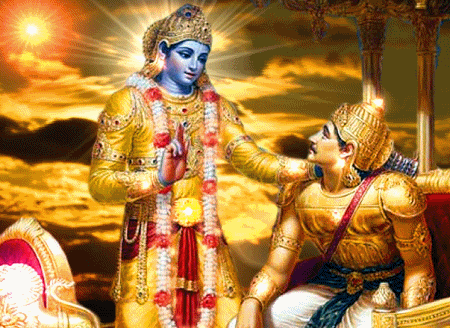STUDY NOTES:
The Bhagavad Gita
*read "Setting the scene" in the forward to the Bhagavad Gita
*read "Setting the scene" in the forward to the Bhagavad Gita
*the advantages of reading the Gita (Bg Intro page 31-33 or 27-28 Mac/Bg
8.28p last para)
*the history of the speaking of the Gita (Bg 4.1+p/4.2+p, last 2 paras)
*qualifications for hearing the Gita (Bg 4.3+p/Bg 9.1/Bg 18.64/Bg
18.67+p/Bg 18.68p)
*one should accept Krsna as the Supreme Personality of Godhead at least
theoretically before one attempts to read His Gita (Bg Intro page 6-7, or
6 Mac)
*qualifications for speaking the Gita (Bg 9.1p, last para)
*one should learn the Bhagavad Gita from a devotee (Bg 8.28 last para)
*anyone who hears the Gita will be freed from the darkness of ignorance
(Bg 18.72p/18.73)
*the essence of studying the Gita (Bg 10.11p 4th para/Bg 18.78p 4th para)
*devotional service is the objective of the Bhagavad Gita and all Vedic
literature (Bg 18.1p 1st para)
*the "Gita teaches us how to absorb the mind and intelligence in the
thought of the Lord". (Bg Intro page 29-30 or 26 Mac)
*the three subjects of the Gita (Bg Intro page 8-14 or 7-12 Mac)
*Summary by Srila Prabhupada (Bg 18.78p)
Ch 1 Observing the armies-Sanjaya describes the battlefield and Arjuna
decides not to fight
Ch 2 Contents of the Gita summarized-the soul, ksatriya duty, karma yoga
and the transcendental position
Ch 3 Karma yoga-prescribed duties according to varnasrama explained and
sacrifice, and lust and the means of conquering it
Ch 4 Transcendental knowledge-Krsna's position as the Supreme
Personality of Godhead, the importance of guru and disciplic
succession and how sacrificial work culminates in jnana yoga
Ch 5 Karma yoga-action in Krsna Consciousness-characteristics of a karma
yogi or a detached worker
Ch 6 Dhyana yoga-controlling the mind, astanga yoga, the fallen yogi, the
best yogi
Ch 7 Knowledge of the Absolute-Krsna and His energies, and theists,
atheists and materialists
Ch 8 Attaining the Supreme-moment of death for bhakti yogi and others
Ch 9 Most Confidential knowledge-Krsna's position, different types of
worship and His devotees (Bg 9.1p 1st part of 3rd para)
Ch 10 Opulence of the Absolute-Krsna's specific opulences manifest in
this world
Ch 11 Universal Form-a challenge to the "pseudo-Gods", and the importance
of the Lord's original form
Ch 12 Devotional Service-the various practitioners of yoga culminating
with the bhakti yoga, whose characteristics are described
Ch 13 Nature, the Enjoyer and Consciousness-distinction and
interrelationship of the body (matter), soul and Supersoul
Ch 14 Three Modes of Nature-how they act, bind and how one is freed
Ch 15 Yoga of the Supreme Person-how to break attachment to the material
world and attain union with the Supreme Person who is the goal of
all the Vedas
Ch 16 Divine and Demoniac natures-explained
Ch 17 Divisions of faith-conditioned in food, sacrifice, austerity, and
charity by the 3 modes, and transcendental faith and worship
explained
Ch 18 Conclusion, Perfection of Renunciation-synopsis and conclusion of
the Gita. Purpose of renunciation, akarma, analysis of effects of
3 modes, 4 varnas, transcendence, surrender, devotion, preaching,
Arjuna's decision and Sanjaya's final conclusion
*The three parts of the Gita explained (Bg 13.1p 2nd para)
Chapters 1-6 deal with the distinction between the material body and the
non-material, eternal living entity and how he can become liberated
through various types of yoga culminating in bhakti yoga or Krsna
Consciousness (Ch 6.47)
Chapters 7-12 introduce the Supreme Lord, His different opulences and
energies, and the Lord's relationship, particularly through bhakti yoga,
with His superior energy, the individual soul. These middle chapters are
the essence of the Gita. (Bg 8.28p 4th para)
Chapters 13-18 describe how the living entity comes in contact with the
material energy, how he is conditioned by it and how he is delivered
through various means such as jnana, karma and finally bhakti,
conclusively the only feasible means.
*The Gita should be accepted in the spirit of one taking medicine (Bg
Intro page 3)
*Five basic truths of the Gita: (i) isvara (ii) jiva (iii) prakrti (iv)
kala (v) karma (Bg Intro Page 8-11 or 7-10 Mac)
*the content and benefits of reading the Bhagavad Gita (SB 1.15.27+p)
LINK FOR THE KURU FAMILY TREE:
http://en.wikipedia.org/wiki/Mahabharata#Kuru_family_tree
